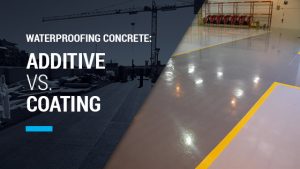Concrete is renowned as a strong material, but it has one major weakness. And unfortunately this weakness just happens to be very abundant – water. Because contact with moisture is inevitable in most situations, concrete must be waterproofed in order for it to offer the longevity and continued strength required of it.
The structure of concrete features a network of capillaries which form as part of the curing process. These capillaries and micro-cracks allow moisture to penetrate the material, which can eventually lead to the development of rust and larger cracks within the concrete. Waterproofing aims to stop this water penetration. There are two main methods of concrete waterproofing; by using additives to create hydrophobic concrete, or by applying a coating after the concrete is set.
Hydrophobic concrete
First developed in Australia, the basic concept around hydrophobic concrete is to use an additive to fill those cracks and capillaries as they form in the concrete during the curing process. While this option is more expensive upfront, hydrophobic concrete saves on a lot of time and manpower that would usually be spent on coating the concrete after it sets.
The main downside to hydrophobic concrete is the fact that it requires certain weather conditions to be able to set properly. It needs to be dry and moderately warm over a period of days for the admixture to set effectively, and inclement weather can mean that the hydrophobic concrete doesn’t turn out to be particularly hydrophobic at all.
Waterproof coating
The more common waterproofing option, a waterproof concrete coating is exactly what you’d expect – a waterproof layer added to the concrete after it has set. This lowers the upfront cost of the concrete itself, but it does mean a greater amount of time and money will need to be spent in order to coat the material. Coatings can either be sprayed or painted on.
This method is generally a little more reliable, as it is less reliant on perfect weather and can be done at any point between the setting and installation of the concrete.
Which method is better? It depends on your situation. But provided the waterproofing is done correctly, both options are equally effective.


